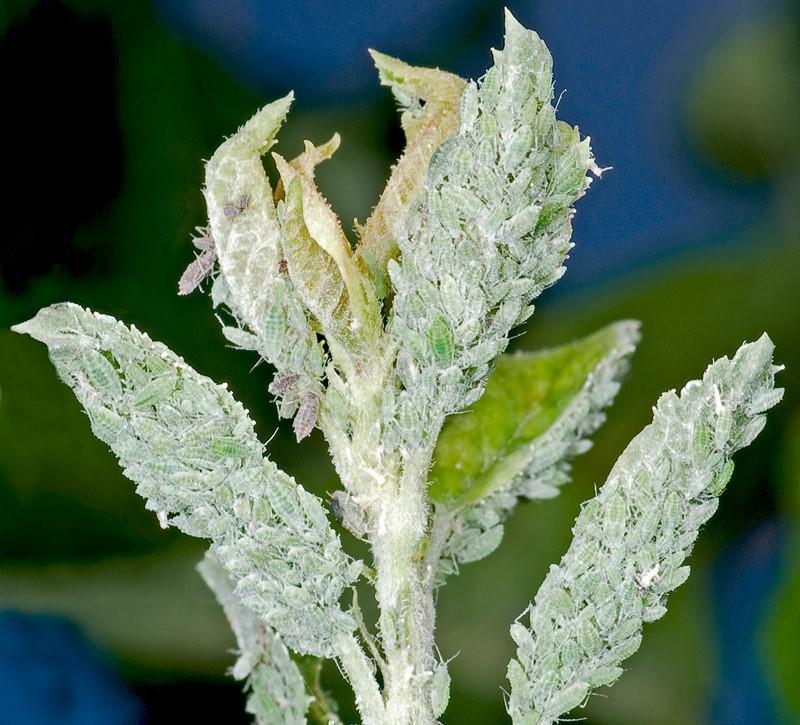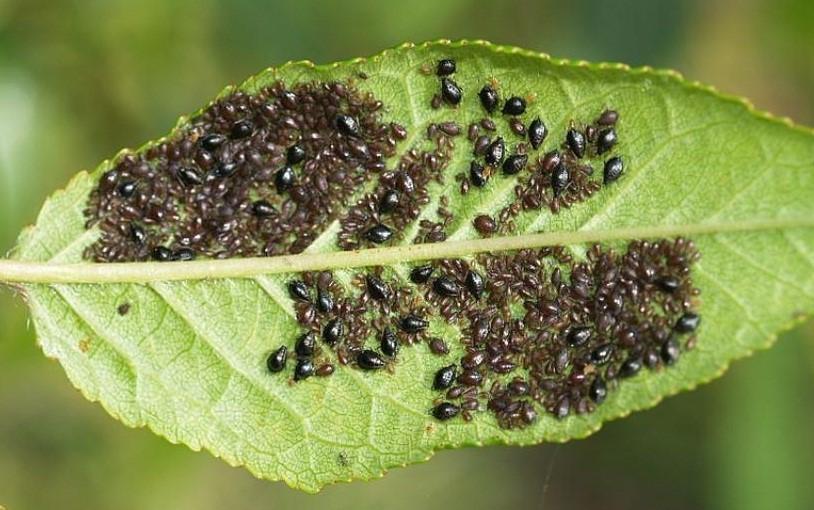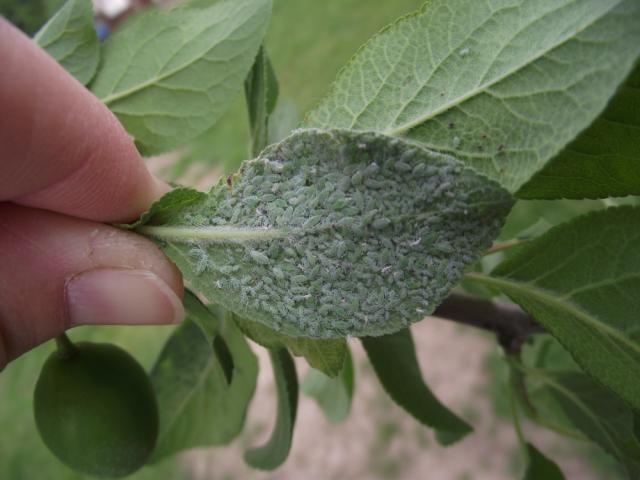How to deal with the dangerous pest of plum aphids
 The first mass appearance of pests in the garden is observed in late spring and in the first half of summer. What is the danger of aphids on the plum, how to deal with these insects without endangering the future harvest?
The first mass appearance of pests in the garden is observed in late spring and in the first half of summer. What is the danger of aphids on the plum, how to deal with these insects without endangering the future harvest?
Plum-pollinated aphids and other varieties
In nature, there are many species of aphids, which in one way or another harm garden and garden plantings. For plum, cherry, cherry plum, sweet cherry, apricot, peach and other stone fruit crops, one of the most dangerous pests is the plum-pollinated aphid.

- weakening of the shoots, which become the desired prey of other pests and are stronger than the rest suffering from lack of nutrition, cold drying;
- deformation of young leaves, taking the shape of a spoon or boat;
- mass destruction of a fruit plant by a sooty fungus and pathogens;
- early fall of foliage and poor preparation of trees for wintering;
- decrease in yields this and the following season.
While the warm period lasts, the pollinated plum aphid can give ten generations. At the same time, insect eggs wait out the winter not only in cracks in the bark, but also on nearby grasses, preferring cereals and reeds.
Green aphids on a plum become visible when the number of insects is critical. But it is much easier to find a black, cherry variety that does not shun other types of stone fruit crops. This pest, giving up to 14 generations, is no less dangerous. The defeat by them leads to the complete collapse of the tops of young shoots, the cessation of their growth and foliage development.
Aphids of all kinds are dangerous because they can spread quickly. Winged individuals migrate independently, and wingless individuals are transferred from plant to plant by ants literally grazing aphids in hunt for the sweet secret of insects.
Damage to the garden with this soft-bodied pest can lead to weakening of trees and loss of yield. How to deal with aphids on a drain? When and what measures should be taken to maximize the effect?
The best and stable results are obtained only by an integrated approach, including preventive work to protect the garden, adherence to agricultural practices and regular processing of not only plums, but also those near growing crops.
Plum aphid chemicals
 Aphids that feed on sap plants are easily destroyed by modern insecticides. The category of aphid control agents is called aphicides and includes drugs:
Aphids that feed on sap plants are easily destroyed by modern insecticides. The category of aphid control agents is called aphicides and includes drugs:
- damaging pests in contact with the treated surface;
- penetrating inside with cell juice;
- acting systemically and giving a long-term effect.
 Commercially available formulations are available, can be used to kill other plum enemies, and are highly soluble in water, making processing easier and cheaper.
Commercially available formulations are available, can be used to kill other plum enemies, and are highly soluble in water, making processing easier and cheaper.
It is not surprising that when answering the question: "What to do with aphids on the plum?", Many experienced gardeners, without a shadow of a doubt, speak of the need for urgent spraying. You really shouldn't hesitate.
Without human intervention, aphids will capture the young part of the crown in a matter of days.But neglect of safety rules and failure to comply with the processing time threatens not only danger to plants, but also harm to human health.
Chemical insecticides are the only correct solution in case of massive damage to plants, as well as in spring and autumn, when insects are not yet species. The choice of a specific drug depends on the degree of damage to the garden, the presence of other insects on the branches, the time when aphids were noticed and the preferences of the gardener himself. Before how to deal with aphids at the drain, you need to remember that the wrong use of insecticides threatens:
- burns of the green part of plants;
- falling flowers and ovary;
- accumulation of chemicals in fruits;
- damage to the skin, organs of rhenium and human respiration.
Therefore, no matter what remedy for aphids on the drain he uses, you need to strictly adhere to the instructions, not forgetting about personal safety.
Features of processing plums from green aphids
The fight against aphids is carried out in several stages. If there are no insects on the trees, or individual individuals are found, it is not worth spraying with chemicals. Aphids, especially on small seedlings, are easily destroyed by hand or folk remedies using herbal infusions, soap or ash solutions.
 A gardener who knows how to treat aphids on a drain needs to imagine for what time it is better to plan such treatment:
A gardener who knows how to treat aphids on a drain needs to imagine for what time it is better to plan such treatment:
- The first time the procedure is carried out in early spring before the kidneys open. It is impossible to see insects at this time. But if they covered the shoots in abundance last season, there is a high probability that there are aphid eggs near the buds and under the crown.
- Fruit trees are re-cultivated at the green cone stage. At this moment, the probability of the destruction of already hatched larvae, which quickly form multimillion colonies, is high.
- If in the spring the measures to control the plum aphid were not taken or did not give the desired result, it is possible to spray the flowering garden when the flowers are just opening and have almost completely fallen off.
In order not to risk their own health, synthetic drugs are used at least 30 days before harvesting. When the fruits are already poured, and the degree of damage is small, it is better to use safe folk methods of dealing with the pest.
In the fall, after removing the fruits, the last treatment of the year is performed with the help of ready-made insecticides or a 5% urea solution, not only effective against black and green aphids on the plum, but also protecting trees from scab.
It is necessary to spray trees in dry, calm weather, preferably in the morning or evening hours, when the risk of sunburn on wet foliage is minimal. During irrigation, special attention is paid to young shoots and the back of the leaves, as well as to the near-stem circles.
How to get rid of aphids on a plum with folk remedies
 Before the formation of the ovary, neither folk remedies nor chemical insecticides are harmful. And how to process aphid plum after flowering? An excellent alternative is proven folk remedies based on herbal infusions, soap-ash and other solutions.
Before the formation of the ovary, neither folk remedies nor chemical insecticides are harmful. And how to process aphid plum after flowering? An excellent alternative is proven folk remedies based on herbal infusions, soap-ash and other solutions.
To prepare a soap-ash liquid, you will need:
- 400 grams of sifted wood ash:
- 50 grams of liquid or laundry soap;
- 10 liters of water.
Before use, a solution that is effective in moderate pest infestation is thoroughly filtered. Tobacco infusion mixed with soapy water will bring no less benefit. Instead of ash, you can take 10 ml of birch tar. This oily scent repels insects and has a strong antibacterial effect. Fumigation of plantings with tobacco smoke gives good results.
Many plants contain substances that act on garden pests similar to industrial insecticides. Moreover, they are safe for humans and the environment. How to get rid of aphids with plants?
To prepare such folk remedies for 10 liters of water at the choice of the gardener, you will need:
- 200 grams of garlic cloves;
- 300 grams of onions;
- 1 kg of herbal raw materials based on pharmacy chamomile or caustic buttercup;
- 4 kg of fresh tomato or potato tops;
- 100 grams of hot chilli pepper;
- 1 kg of yarrow herb, tansy or wormwood.
An adult fruit tree requires about 10 liters of infusion. Severely affected shoots should not just be sprayed, but immersed as much as possible in a liquid so that it penetrates into the deformations formed by pollinated plum aphids.
Preventive measures against plum aphids
 Since the pest easily migrates and multiplies quickly, before treating aphids on a plum with folk remedies or insecticides, you should pay attention to:
Since the pest easily migrates and multiplies quickly, before treating aphids on a plum with folk remedies or insecticides, you should pay attention to:
- fighting ants;
- correct and regular pruning of the crown;
- maintaining the health of the tree trunk;
- digging and mulching of trunk circles;
- elimination of weeds and root growth.
There are other ways to make the insect habitat uncomfortable.
The pollinated plum aphid pests not only on stone fruit crops, but also on reeds, wild grasses and other plants. The insect is especially attracted by peas and beans, young shoots beans and nasturtium, petunia, small-leaved and cultivated large-leaved Linden... These plants are planted at a distance from plums and other fruits. If this is not possible, then they are sprayed along with stone fruit crops.
 Among the inhabitants of the garden, there are also green repellents that repel aphids. For the most part, these are essential oil plants, which include mint and basil, lavender and lemon balm, cilantro and unpretentious marigolds. Umbrella garden plants, for example, carrots, fennel, dill and other spicy-flavoring herbs, perfectly lure predatory insects, for which the green aphid on the plum is a welcome delicacy.
Among the inhabitants of the garden, there are also green repellents that repel aphids. For the most part, these are essential oil plants, which include mint and basil, lavender and lemon balm, cilantro and unpretentious marigolds. Umbrella garden plants, for example, carrots, fennel, dill and other spicy-flavoring herbs, perfectly lure predatory insects, for which the green aphid on the plum is a welcome delicacy.
The invasion of aphids scares novice gardeners in mass. However, with the observance of agricultural technology, maintaining cleanliness under the trees and their timely processing, insects, the number of which is easy to control, cease to be a serious threat.